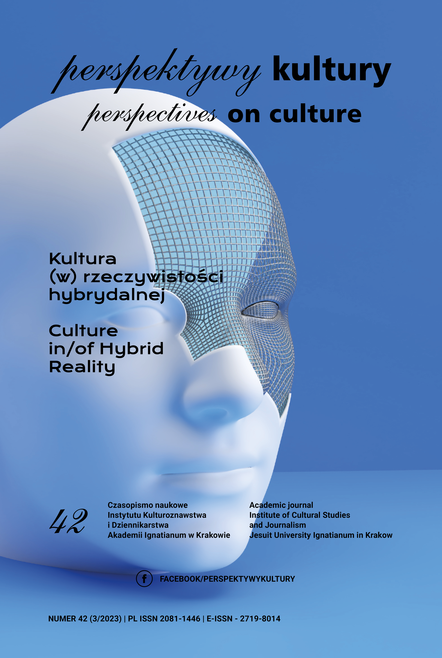Paradoxes of Time Travel in Juliusz Machulski’s Cinema
Abstract
The subject of time travel has been scarcely explored in Polish cinema. How Much Does The Trojan Horse Weigh? (2008) and EmbaSSy (2013) directed by Juliusz Machulski, a shrewd observer and ruthless critic of the Polish social situation over the past four decades, are rare examples. Best known for his 1980s comedies exposing the absurdities of the communist regime, Machulski takes us on a journey back in time in his two post-millennial time travel films. How Much Does The Trojan Horse Weigh? shifts us back to 1987 and revisits the reality of communism in Poland, whilst EmbaSSy transports us to 1939, where World War II is about to begin. The aim of this paper is to examine Juliusz Machulski’s vision of time travel, its paradoxes and consequences, as well as the nature of diegetic realities within his time travel films.
References
Al-Khalili, J. (2003). Black Holes, Wormholes and Time Machines. Bristol: Institute of Physics Publishing.
Bould, M., Butler, A.M., Roberts, A., & Vint, S. (eds.). (2009). The Routledge Companion to Science Fiction. New York: Routledge.
Frey, D. (2021). The Four Types of Time Travel (And What They Say About Ourselves and the World Around Us). Retrieved from: https://crimereads.com/the-four-types-of-time-travel-and-what-they-say-about-ourselves-and-the-world-around-us/ (access: 22.10.2022).
Gleick, J. (2017). Time Travel: A History. London: Harper Collins Publish-ers.
Koberlein, B. (2015). Why It’s Impossible To Go Back In Time And Kill Baby Hitler. Retrieved from: https://www.forbes.com/sites/briankoberlein/2015/10/23/why-its-impossible-to-go-back-in-time-and-kill-baby-hitler/?sh=179622329c02 (access: 22.10. 2022).
Majer, A. (2014). Kino Juliusza Machulskiego. Bielsko-Biała: Wydawnictwo Kwieciński.
Meslow, S. (2012). A Brief history of Time Travel (In Movies). Retrieved from: https://www.theatlantic.com/entertainment/archive/2012/05/a-brief-history-of-time-travel-in-movies/257638/#:~:text=The%20first%20three%20notable%20entries,talkie%2C%20and%20a%201949%20musical (access: 22.10.2022).
Olczak-Moraczewska, H. (2009). Juliusz Machulski. Retrieved from: https://culture.pl/en/tworca/juliusz-machulski (access: 22.10.2022).
Petruzzello, M. (ed). Predestination. Encyclopedia Britannica. Retrieved from: https://www.britannica.com/topic/predestination (access: 22.10.2022).
Rafferty, J.P. (ed). Edward Lorenz. Encyclopedia Britannica. Retrieved from: https://www.britannica.com/biography/Edward-Lorenz (access: 22.10.2022).
Sherman, F.A. (2017). Now and Then We Travel. Visiting Pasts and Futures in Film and Television. Jefferson, North Carolina: McFarland & Com-pany Inc. Publishers.
St. James, E. (2016). ‘Back to the Future’ is the most perfect blockbuster ever made. I will not hear otherwise. Retrieved from: https://www.vox.com/2015/7/1/8876073/back-to-the-future-anniversary-30 (access: 22.10.2022).
Wasserman, R. (2018). Paradoxes of Time Travel. Oxford: Oxford Univer-sity Press.
Filmography
A Connecticut Yankee in King Arthur’s Court, dir. Emmett J. Flynn, USA: Fox Film, 1921.
A Connecticut Yankee in King Arthur’s Court, dir. David Butler, USA: Fox Film Corporation, 1931.
A Connecticut Yankee in King Arthur’s Court, dir. Tay Garnett, USA: Par-amount Pictures, 1949.
Back to the Future, dir. Robert Zemeckis, USA: Universal Pictures, 1985.
Back to the Future Part II, dir. Robert Zemeckis, USA: Universal Pictures, 1989.
Back to the Future Part III, dir. Robert Zemeckis, USA: Universal Pictures, 1990.
EmbaSSy (AmbaSSada), dir. Juliusz Machulski, Poland: Studio Filmowe Zebra, 2013.
Groundhog Day, dir. Harold Ramis, USA: Columbia Pictures, 1993.
Hour Of The Crimson Rose (Godzina pąsowej róży), dir. Halina Bielińska, Poland: Wytwórnia Filmów Fabularnych, 1963.
How Much Does The Trojan Horse Weigh? (Ile waży koń trojański?), dir. Juliusz Machulski, Poland: Studio Filmowe Zebra, 2008.
Kiler, dir. Juliusz Machulski, Poland: Studio Filmowe Zebra, 1997.
Midnight in Paris, dir. Woody Allen, USA: Sony Pictures Classics, 2011.
Sexmission (Seksmisja), dir. Juliusz Machulski, Poland: Zespół Filmowy Kadr, 1984.
Superproduction (Superprodukcja), dir. Juliusz Machulski, Poland: Studio Filmowe Zebra/Vision Film, 2003.
The Adam Project, dir. Shawn Levy, USA: Netflix, 2022.
The Hourglass Sanatorium (Sanatorium pod klepsydrą), dir. Wojciech Jerzy Has, Poland: Zespół Filmowy Silesia, 1973.
The Lullaby (Kołysanka), dir. Juliusz Machulski, Poland: Studio Filmowe Zebra, 2010.
The Time Machine, dir. George Pal, USA: Metro-Goldwyn-Mayer/Galaxy Films, 1960.
The Time Machine, dir. Simon Wells, USA: Warner Bros., 2002.
Vabank, dir. Juliusz Machulski, Poland: Zespół Filmowy Kadr, 1981.
Vinci, dir. Juliusz Machulski, Poland: Studio Filmowe Zebra, 2004.
Copyright (c) 2022 Perspectives on Culture

This work is licensed under a Creative Commons Attribution-NoDerivatives 4.0 International License.
Autor, zgłaszając swój artykuł, wyraża zgodę na korzystanie przez Wydawnictwo Uniwersystet Ignatianum z utworu na następujących polach eksploatacji:
- utrwalania utworu w formie papierowej, a także na nośniku cyfrowym lub magnetycznym;
- zwielokrotnienia utworu dowolną techniką, bez ograniczenia ilości wydań i liczby egzemplarzy;
- rozpowszechniania utworu i jego zwielokrotnionych egzemplarzy na jakimkolwiek nośniku, w tym wprowadzenia do obrotu, sprzedaży, użyczenia, najmu;
- wprowadzenia utworu do pamięci komputera;
- rozpowszechniania utworu w sieciach informatycznych, w tym w sieci Internet;
- publicznego wykonania, wystawienia, wyświetlenia, odtworzenia oraz nadawania i reemitowania, a także publicznego udostępniania utworu w taki sposób, aby każdy mógł mieć do niego dostęp w miejscu i czasie przez siebie wybranym.
Wydawca zobowiązuje się szanować osobiste prawa autorskie do utworu.





